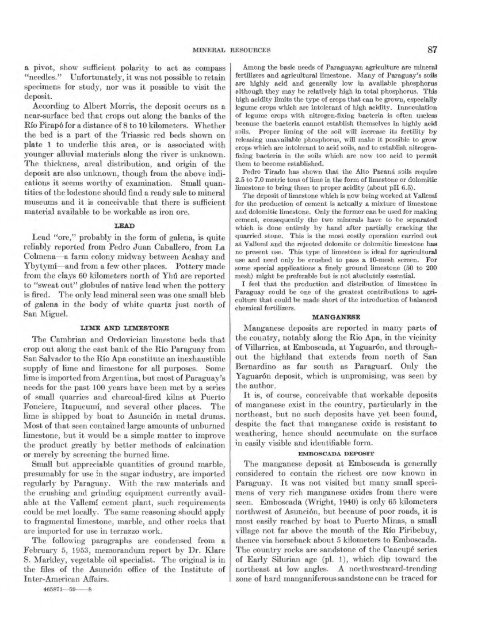Geology and Mineral Resources of Paraguay A Reconnaissance
Geology and Mineral Resources of Paraguay A Reconnaissance
Geology and Mineral Resources of Paraguay A Reconnaissance
- No tags were found...
Create successful ePaper yourself
Turn your PDF publications into a flip-book with our unique Google optimized e-Paper software.
MINERAL RESOURCES 87a pivot, show sufficient polarity to act as compass"needles." Unfortunately, it was not possible to retainspecimens for study, nor was it possible to visit thedeposit.According to Albert Morris, the deposit occurs as anear-surface bed that crops out along the banks <strong>of</strong> theRio Pirapo for a distance <strong>of</strong> 8 to 10 kilometers. Whetherthe bed is a part <strong>of</strong> the Triassic red beds shown onplate 1 to underlie this area, or is associated withyounger alluvial materials along the river is unknown.The thickness, areal distribution, <strong>and</strong> origin <strong>of</strong> thedeposit are also unknown, though from the above indicationsit seems worthy <strong>of</strong> examination. Small quantities<strong>of</strong> the lodestone should find a ready sale to mineralmuseums <strong>and</strong> it is conceivable that there is sufficientmaterial available to be workable as iron ore.LEADLead "ore," probably in the form <strong>of</strong> galena, is quitereliably reported from Pedro Juan Caballero, from LaColmena a farm colony midway between Acahay <strong>and</strong>Ybytymi <strong>and</strong> from a few other places. Pottery madefrom the clays 60 kilometers north <strong>of</strong> Yhu are reportedto "sweat out" globules <strong>of</strong> native lead when the potteryis fired. The only lead mineral seen was one small bleb<strong>of</strong> galena in the body <strong>of</strong> white quartz just north <strong>of</strong>San Miguel.LIME AND LIMESTONEThe Cambrian <strong>and</strong> Ordovician limestone beds thatcrop out along the east bank <strong>of</strong> the Rio <strong>Paraguay</strong> fromSan Salvador to the Rio Apa constitute an inexhaustiblesupply <strong>of</strong> lime <strong>and</strong> limestone for all purposes. Somelime is imported from Argentina, but most <strong>of</strong> <strong>Paraguay</strong>'sneeds for the past 100 years have been met by a series<strong>of</strong> small quarries <strong>and</strong> charcoal-fired kilns at PuertoFonciere, Itapucumi, <strong>and</strong> several other places. Thelime is shipped by boat to Asuncion in metal drums.Most <strong>of</strong> that seen contained large amounts <strong>of</strong> unburnedlimestone, but it would be a simple matter to improvethe product greatly by better methods <strong>of</strong> calcinationor merely by screening the burned lime.Small but appreciable quantities <strong>of</strong> ground marble,presumably for use in the sugar industry, are importedregularly by <strong>Paraguay</strong>. With the raw materials <strong>and</strong>the crushing <strong>and</strong> grinding equipment currently availableat the Vallemi cement plant, such requirementscould be met locally. The same reasoning should applyto fragmental limestone, marble, <strong>and</strong> other rocks thatare imported for use in terrazzo work.The following paragraphs are condensed from, aFebruary 5, 1953, memor<strong>and</strong>um report by Dr. KlareS. Marldey, vegetable oil specialist. The original is inthe files <strong>of</strong> the Asuncion <strong>of</strong>fice <strong>of</strong> the Institute <strong>of</strong>Inter-American Affairs.465871 59 8Among the basic needs <strong>of</strong> <strong>Paraguay</strong>an agriculture are mineralfertilizers <strong>and</strong> agricultural limestone. Many <strong>of</strong> <strong>Paraguay</strong>'s soilsare highly acid <strong>and</strong> generally low in available phosphorusalthough they may be relatively high in total phosphorus. Thishigh acidity limits the type <strong>of</strong> crops that can be grown, especiallylegume crops which are intolerant <strong>of</strong> high acidity. Innoculation<strong>of</strong> legume crops with nitrogen-fixing bacteria is <strong>of</strong>ten uselessbecause the bacteria cannot establish themselves in highly acidsoils. Proper liming <strong>of</strong> the soil will increase its fertility byreleasing unavailable phosphorus, will make it possible to growcrops which are intolerant to acid soils, <strong>and</strong> to establish nitrogenfixingbacteria in the soils which are now too acid to permitthem to become established.Pedro Tirade has shown that the Alto Parana soils require2.5 to 7.0 metric tons <strong>of</strong> lime in the form <strong>of</strong> limestone or dolomiticlimestone to bring them to proper acidity (about pH 6.5).The deposit <strong>of</strong> limestone which is now being worked at Vallemifor the production <strong>of</strong> cement is actually a mixture <strong>of</strong> limestone<strong>and</strong> dolomitic limestone. Only the former can be used for makingcement, consequently the two minerals have to be separatedwhich is done entirely by h<strong>and</strong> after partially cracking thequarried stone. This is the most costly operation carried outat Vallemi <strong>and</strong> the rejected dolomite or dolomitic limestone hasno present use. This type <strong>of</strong> limestone is ideal for agriculturaluse <strong>and</strong> need only be crushed to pass a 10-mesh screen. Forsome special applications a finely ground limestone (50 to 200mesh) might be preferable but is not absolutely essential.I feel that the production <strong>and</strong> distribution <strong>of</strong> limestone in<strong>Paraguay</strong> could be one <strong>of</strong> the greatest contributions to agriculturethat could be made short <strong>of</strong> the introduction <strong>of</strong> balancedchemical fertilizers.MANGANESEManganese deposits are reported in many parts <strong>of</strong>the country, notably along the Rio Apa, in the vicinity<strong>of</strong> Villarrica, at Emboscada, at Yaguaron, <strong>and</strong> throughoutthe highl<strong>and</strong> that extends from north <strong>of</strong> SanBernardino as far south as Paraguari. Only theYaguaron deposit, which is unpromising, was seen bythe author.It is, <strong>of</strong> course, conceivable that workable deposits<strong>of</strong> manganese exist in the country, particularly in thenortheast, but no such deposits have yet been found,despite the fact that manganese oxide is resistant toweathering, hence should accumulate on the surfacein easily visible <strong>and</strong> identifiable form.EMBOSCADA DEPOSITThe manganese deposit at Emboscada is generallyconsidered to contain the richest ore now known in<strong>Paraguay</strong>. It was not visited but many small specimens<strong>of</strong> very rich manganese oxides from there wereseen. Emboscada (Wright, 1940) is only 65 kilometersnorthwest <strong>of</strong> Asuncion, but because <strong>of</strong> poor roads, it ismost easily reached by boat to Puerto Minas, a smallvillage not far above the mouth <strong>of</strong> the Rio Piribebuy,thence via horseback about 5 kilometers to Emboscada.The country rocks are s<strong>and</strong>stone <strong>of</strong> the Caacupe series<strong>of</strong> Early Silurian age (pi. 1), which dip toward thenortheast at low angles. A northwestward-trendingzone <strong>of</strong> hard mano;aniferous s<strong>and</strong>stone can be traced for
















